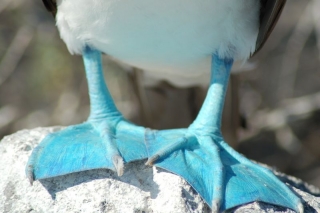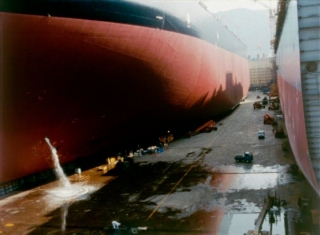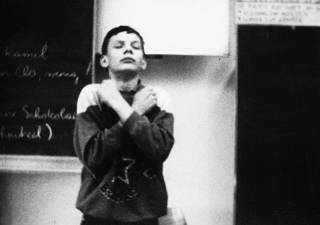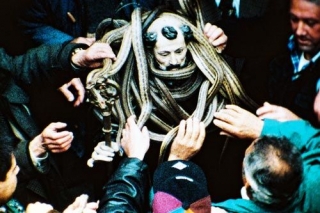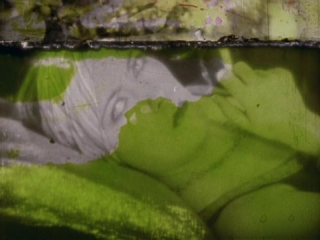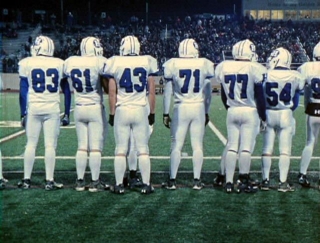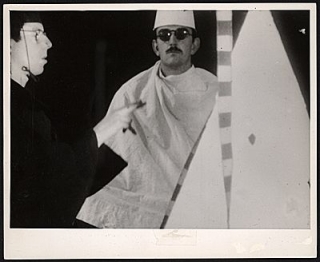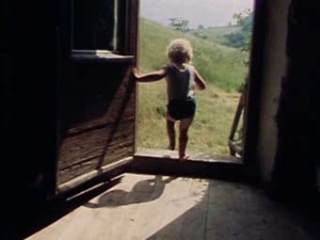Date: 25 October 2010 | Season: London Film Festival 2010 | Tags: London Film Festival
LEWIS KLAHR: ENGRAM SEPALS (MELODRAMAS 1994-2000)
Monday 25 October 2010, at 7pm
London Tate Modern
Collage artist Lewis Klahr introduces Engram Sepals, his celebrated sequence of seven films which traces ‘a trajectory of American intoxication’. Appropriating the imagery of pop culture from the aspirational 1940s through the free-loving 1970s, Klahr’s cut-out animations draw us into a dreamlike world of intrigue, anxiety and lust. A surreal and atmospheric epic propelled by an evocative soundtrack featuring Frank Sinatra, Morton Feldman, Mercury Rev and The Stooges.
Lewis Klahr, Altair, 1994, 8 min
Lewis Klahr, Engram Sepals, 2000, 6 min
Lewis Klahr, Elsa Kirk, 1999, 5 min
Lewis Klahr, Pony Glass, 1997, 15 min
Lewis Klahr, Govinda, 1999, 23 min
Lewis Klahr, Downs Are Feminine, 1994, 9 min
Lewis Klahr, A Failed Cardigan Maneuver, 1999, 15 min
Lewis Klahr’s work has been featured in three Whitney Biennials and is in the collection of the Museum of Modern Art, New York. He is a faculty member at CalArts, received a Guggenheim Fellowship in 1992, and was ranked 4th in the Film Comment avant-garde poll of this decade’s most important filmmakers. The Wexner Center, Columbus, recently presented a retrospective of Klahr’s films and contributed towards the preparation of a DVD box set.
Curated by Mark Webber and presented in association with The 54th BFI London Film Festival.
Lewis Klahr will introduce a screening of new work at BFI Southbank on Sunday 24 October 2010.
PROGRAMME NOTES
LEWIS KLAHR: ENGRAM SEPALS (MELODRAMAS 1994-2000)
Monday 25 October 2010, at 7pm
London Tate Modern
ALTAIR
Lewis Klahr, 1994, USA, 16mm, colour, sound, 8 min
“Altair offers a cut-out animation version of colour noir. The images were culled from six late 1940s issues of Cosmopolitan magazine and then set to an almost four-minute section of Stravinsky’s Firebird (looped twice) to create a sinister, perfumed world. As in my 1988 visit to this genre, In the Month of Crickets, the narrative is highly smudged, leaving legible only the larger signposts of the female protagonist’s story. The viewer is encouraged to speculate on the nature and details of the woman’s battle with large, malevolent societal forces and her descent into an alcoholic swoon. However I feel it is important to add that what interested me in making this film was very little of what is described above, but instead a fascination with the colour blue and some intangible association it has for me with the late 1940s.” (Lewis Klahr)
ENGRAM SEPALS
Lewis Klahr, 2000, USA, 16mm, b/w, sound, 6 min
“The dead body remembers. The Tibetan book of the dead meets film noir. An elliptical narrative of adultery and corporate espionage set to a score by Morton Feldman.” (Lewis Klahr)
ELSA KIRK
Lewis Klahr, 1999, USA, 16mm, colour, sound, 5 min
“In the mid-1990s I unearthed three photographic contact sheets of three different women in a thrift store in the East Village. Only one was named and dated – Elsa Kirk, Feb 22 ’63 – but all looked like they were from the same photographer and time period. There were 12 images per sheet of these models/actresses and I found myself quite moved by the strong sense of aspiration in their poses, by the poignant blend of fiction and reality. At first, I was unable to translate these images into collage animation. So instead, I began making Xerox enlargements of the sheets that I turned into a series of flat collages. Eventually these became storyboards for the films and led to the hieroglyphic montage style of the completed [work] – an approach that I had intuited when first attracted to the potential of cut-outs two decades ago, but had never been able to capture on film.” (Lewis Klahr)
PONY GLASS
Lewis Klahr, 1997, USA, 16mm, colour, sound, 15 min
“Pony Glass is the story of comic book character Jimmy Olsen’s secret life. In this 15-minute cut-out animation, Superman’s pal embarks on his most adult adventure ever as he navigates the treacherous shoals of early 1960s romance trying to resolve a sexual identity crisis of epic proportions. A three-act melodrama – each act has its own song – filmed in my signature collage style that ‘unmasks’ our collective iconic inheritance as Americans while significantly expanding the notion of what a music video can do.” (Lewis Klahr)
GOVINDA
Lewis Klahr, 1999, USA, 16mm, colour, sound, 23 min
“A three act countercultural coming of age melodrama told from a generational rather than individual point of view. Beginning with appropriated student, Super-8 footage of a 1970s alternative high school and finishing with footage I shot a month after college graduation of my brother’s hippie wedding, Govinda charts a path from innocence to too much experience.” (Lewis Klahr)
DOWNS ARE FEMININE
Lewis Klahr, 1994, USA, 16mm, colour, sound, 9 min
“Lewis Klahr’s Downs Are Feminine unveils a kind of rainy day, indoor, peaceable kingdom of desultory and idyllic debauchery, masturbatory reveries and hermaphroditic transformations. Klahr’s oneiric collages graft 1970s porn of pallid stubbly flesh flagrantly onto Good Housekeeping / Architectural Digest décor (varicoloured crab-orchard stone foyers, modacrylic sunbursts, jalousie windows and orientalist metal scrollwork), interior states where characters despoil themselves in Quaalude interludes of dreamy couplings. In this out-of-touch realm, touching is intelligence gathering for a carnal knowledge that will never attain its platonic ideal. The whole atmosphere is pervaded with euphoria, a hopelessness without despair, a contentment beyond longing.” (Mark McElhatten, New York Film Festival)
A FAILED CARDIGAN MANEUVER
Lewis Klahr, 1999, USA, 16mm, colour, sound, 15 min
“Children in a garden of outsized fruit dream of food and love, then grow up to have unhappy office love affairs in the glamorous Manhattan of the late 1950s.” (J. Hoberman, Village Voice)
Back to top
Date: 27 October 2010 | Season: London Film Festival 2010 | Tags: London Film Festival
DAVID GATTEN’S JOURNAL AND REMARKS
Wednesday 27 October 2010, at 2:30pm
London Natural History Museum
David Gatten, one of the most accomplished young film artists to emerge in recent years, returns to London to discuss a visit to the Galapagos Islands and screen the film he photographed there. The journey was an opportunity to follow in the footsteps of the naturalist Charles Darwin, whose expedition in the 1830s shaped the theory of evolution. The islands off the west coast of Ecuador have changed little since that time and still sustain a unique array of endemic species. In the absence of predatory mammals, native animals do not fear humans, enabling Gatten to shoot in close proximity to such exotic creatures as giant tortoises and blue-footed boobies. ‘The sights I was able to see – and the images I was able to capture – are remarkably similar to the things Darwin saw.’ Shuttling between these observations and texts from an early edition of Voyage of the Beagle, the film is structured in accordance with Leonardo’s proposal to divide the hour into 3000 equal measures. Along with Shrimp Boat Log (also showing in the Festival), it forms part of a forthcoming cycle titled Continuous Quantities.
David Gatten,Journal and Remarks, USA, 2009, 16mm, colour, silent, 15 min
plus extended discussion
Presented as part of Nature Live, in association with the Natural History Museum.
This free event will take place in the Attenborough Studio, Darwin Centre, Natural History Museum, Cromwell Road, London, SW7 5BD. Nearest Tube: South Kensington. Please arrive early to avoid disappointment.
Date: 2 November 2010 | Season: Plenty
PLENTY 1: THE END
Tuesday 2 November 2010, at 7pm
London E:vent Gallery
The screening series PLENTY proposes a new way of looking at artists’ films by showing only a single work, regardless of its duration. Each film is given the freedom to unfold on its own terms, and the viewer is given the time and space to consider it.
“Ladies and gentlemen. We asked you before to insert yourself into the cast, now we ask you to write this story. Here is a character. Here is the most beautiful music on earth. Here are some pictures. What is happening?”
THE END
Christopher Maclaine, USA, 1953, 16mm, b/w & colour, sound, 35 min
The End follows the last day on earth for six of ‘our friends’ living in the shadow of the atomic bomb. Cryptic camerawork and disjointed cutting conspire to salvage narrative from unrelated images, accompanied by a barely coherent rant of existential despair. The End is an anti-film infused with dark, ironic humour; deliciously inept and inadvertently glorious.
Christopher Maclaine (1923-75) was a marginal figure in the early beatnik scene of North Beach, San Francisco. He wrote poetry and prose, and made four films. Maclaine’s heavy use of amphetamines ultimately rendered him debilitated, resulting in hospital internments and early death.
PLENTY, a free monthly screening series selected by Mark Webber, forms part of the “Brief Habits” programme curated by Shama Khanna.
Date: 11 November 2010 | Season: Films of the Sea, Writings
PETER HUTTON’S SEA STORIES
Published on the occasion of “Films of the Sea” at Fondazione Morra, Naples, 11—12 November 2010.
Filmmaker Peter Hutton recounts an early experience as a merchant seaman, and its sustained influence on his practice, as told to Mark Webber on 25 November 2007.
I grew up just outside Detroit and there was series of travelogues shown regularly at the Detroit Art Institute. At that time it was somewhat common for people to make 16mm films about their travels to Europe or to South America, or even to State Parks in America, and they would put together these little films. Of course, when I was young I didn’t think that I would have any relationship to film but these were some of the first more personal film experiences I had. It’s kind of interesting because essentially what I’ve been doing are sorts of travelogues as well, records of my own wandering around the world. My father had been a great traveller as a young man. He also worked as a merchant seaman for a couple of years, not as long as I did, but he got in touch with a certain degree of wanderlust.
Initially I went to sea working on the Great Lakes of the USA. I had these amazing dreams of going to Shanghai and Alexandria and exotic ports around the world, but there I was in the Great Lakes going to Cleveland and Toledo and Ashtabula and these funky mid-western coal towns. I worked there for about four months, saved up some money and then moved to Honolulu. I knew Honolulu was a great port to get a ship, particularly for going to the Far East.
I spent three or four years in Hawaii during the early 1960s, shipping out and also taking classes at the University of Hawaii, which was also very important to me as an artist. Concurrent with my art school education was being exposed to the beauty and the wonder of being at sea. The first and most profound trip I took was from Hawaii to India. Within two weeks of moving to Honolulu I boarded a ship headed for Calcutta – I was just 19 years old and I was never quite the same after that trip; it was the one that really turned my head around in some bigger way.
I actually spent a month there because the ship was damaged and we had to repair it so we just stayed in port. They had to reconfigure the whole propeller because it had been bent. Most the crew moved into fleabag hotels in town, and I remember hiring a young Indian guy to do my work on the ship. Technically, I still had to report to the ship every day and do the midnight to 4 a.m. watch. I hired some Indian guy, as all the crew did, paid him probably a one hundredth of what I was getting paid, and he would do my job while I would wander around Calcutta. That in itself was a life-changing event for me. The most intense visual experience I had during that time was when the company decided to paint the ship while it was being repaired.
This is a very Conradian kind of story of my first ship in the Pacific. The ship had left Tacoma, Washington, and made it as far as Guam in the Pacific when one of the boilers blew up so they towed the ship to Honolulu. The entire crew disembarked and they were repairing the boiler. That’s when I was hired to go on the ship, it was a kind of a wounded beast. I remember walking into the Union Hall for my first encounter with the union people, and the guy said, “Hey kid, you want to go Calcutta?” And I just thought, “Oh my god, this is what I’ve been dreaming about!” So I get down to the ship and I realise it’s a very old ship that has this cargo of wheat all battened down in the holds. I was on board for maybe two weeks in port before we set sail because they couldn’t get a crew together; they were having a hard time getting enough people to man the ship.
Finally when we set sail for India, I realised that it was a pretty dysfunctional crew – a lot of druggies, a lot of alcoholics – it was the most colourful, motley group of characters you could imagine. This made the trip all the more interesting for me, but essentially by the time we got to Calcutta and opened the hatches, the wheat had rotted inside the holds. It was a gift from the US Government to the Indian Government, and it was this supremely decayed cargo of wheat. It was rancid. I remember being amazed by how stinky Calcutta was to begin with; there was this fetid atmosphere in an area called Khidirpur on the waterfront. It was like we were sailing into the asshole of the world, the most violent odour I had ever encountered. Then when they popped open the ship it was even worse: the wheat.
Somehow every kernel of that wheat had to be taken off the ship, and essentially something like three of four hundred men came on board. They would go down into the holds and fill gunny sacks with the wheat, sew them up and then carry them off on their backs. It was an amazing procession, like an ant colony of humans sort of overtaking the ship to unload the cargo. Concurrent with that were several hundred men with little hammers, hanging over the sides of the ship on ropes, chipping the paint off. They were also painting the engine room, so the ship was just inundated with humanity. The impression of seeing that has stayed with me for my whole life; it was the most amazing symphony of humanity and atmosphere. This was an image that I’ll never forget, and I think that memory somewhat foreshadows At Sea, the more recent film about ships. That whole sequence of the film which is shot in Bangladesh, these little guys working on these big ships, is in some way trying to reference or recapture that first experience of being in Calcutta.
These extracts are taken from an interview conducted by Mark Webber for a forthcoming oral history of avant-garde film. Initial research for the project was funded by the British Academy.
Date: 30 November 2010 | Season: Plenty
PLENTY 2: ÄGYPTEN
Tuesday 30 November 2010, at 7pm
London E:vent Gallery
The screening series PLENTY proposes a new way of looking at artists’ films by showing only a single work, regardless of its duration. Each film is given the freedom to unfold on its own terms, and the viewer is given the time and space to consider it.
ÄGYPTEN [EGYPT]
Kathrin Resetarits, Austria, 1997, 16mm, b/w, sound, 10 min
Ägypten takes viewers on a journey into the silent world of sign language, exploring visual communication between people of all ages. Children recount movie scenes and an expedition to the pyramids, a woman signs a traditional Viennese ballad and a group of pensioners socialise. The film uses the power of cinema to explore this theme with humour and compassion.
Kathrin Resetarits (born 1973) is a Viennese writer, actress and filmmaker. Her other films include Fremde (1999) and Ich Bin Ich (2006). She played a leading role in Barbara Albert’s Fallen (1997) and has worked as an assistant to Michael Haneke.
PLENTY, a free monthly screening series selected by Mark Webber, forms part of the “Brief Habits” programme curated by Shama Khanna.
Date: 11 January 2011 | Season: Plenty
PLENTY 3: COCULLO
Tuesday 11 January 2011, at 7pm
London E:vent Gallery
The screening series PLENTY proposes a new way of looking at artists’ films by showing only a single work, regardless of its duration. Each film is given the freedom to unfold on its own terms, and the viewer is given the time and space to consider it.
COCULLO
Nino Pezzella, Italy, 2000-06, 16mm, colour, sound, 30 min
Snakes alive! For the annual Festa dei Serpari in Cocullo, a statue of San Domenico is adorned with snakes and paraded through the village streets, escorted by bagpipes and a marching band. Traditional foods are prepared using time-honoured methods. Pezzella’s dynamic film collides sounds and images as it follows this extraordinary ritual and its participants.
Painter and filmmaker Nino Pezzella (born 1961, Wiesbaden) studied at the Städelschule, Frankfurt, where he now teaches life drawing. His current work documents the lives of the Femminielli in Naples.
PLENTY, a free monthly screening series selected by Mark Webber, forms part of the “Brief Habits” programme curated by Shama Khanna.
Date: 8 February 2011 | Season: Plenty
PLENTY 4: BARBARA’S BLINDNESS
Tuesday 8 February 2011, at 7pm
London E:vent Gallery
The screening series PLENTY proposes a new way of looking at artists’ films by showing only a single work, regardless of its duration. Each film is given the freedom to unfold on its own terms, and the viewer is given the time and space to consider it.
BARBARA’S BLINDNESS
Joyce Wieland & Betty Ferguson, Canada, 1965, 16mm, b/w, sound, 17 min
Constructed from found and stock footage, Barbara’s Blindness is a meditation on vision and adversity, drawing humour and pathos from a moralising educational film. “We started out with a dull film about a little blind girl named Mary and ended up with something that made us get crazy.”
Joyce Wieland (1931-88) was a pioneer of patriotic and feminist Canadian art. Though primarily known as a filmmaker, she was also a distinguished painter and mixed media artist. Wieland’s lifelong friend Betty Ferguson (born 1933) went on to make three found footage films of her own in the 1970s.
PLENTY, a free monthly screening series selected by Mark Webber, forms part of the “Brief Habits” programme curated by Shama Khanna.
Date: 8 March 2011 | Season: Plenty
PLENTY 5: O’ER THE LAND
Tuesday 8 March 2011, at 7pm
London E:vent Gallery
The screening series PLENTY proposes a new way of looking at artists’ films by showing only a single work, regardless of its duration. Each film is given the freedom to unfold on its own terms, and the viewer is given the time and space to consider it.
O’ER THE LAND
Deborah Stratman, USA, 2009, 16mm, colour, sound, 52 min
Marine Corps pilot William Rankin ejected from his jet into a severe thunderstorm, surviving lightening strikes in a 40-minute descent. 50 years later, his account is the starting point for a contemplation of American national identity that takes in Civil War re-enactments, high school football games, gun shows, firefighters and border patrols.
Deborah Stratman (born 1967) is a Chicago-based artist working in photography, sound, drawing and installation. Her films use experimental and documentary techniques to explore an interest in landscapes, mythologies and systems.
PLENTY, a free monthly screening series selected by Mark Webber, forms part of the “Brief Habits” programme curated by Shama Khanna.
Date: 12 April 2011 | Season: Plenty
PLENTY 6: PLASTIC HAIRCUT
Tuesday 12 April 2011, at 7pm
London E:vent Gallery
The screening series PLENTY proposes a new way of looking at artists’ films by showing only a single work, regardless of its duration. Each film is given the freedom to unfold on its own terms, and the viewer is given the time and space to consider it.
PLASTIC HAIRCUT
Robert Nelson, USA, 1963, 16mm, b/w, sound, 15 min
Two actors perform absurd actions in sets composed of geometric shapes. Two experts try to explain what it all means. Goofing off in positive/negative space, Robert Nelson and collaborators William T. Wiley, Ron Hudson, R.G. Davis and Steve Reich construct a spirited work that invokes Alfred Jarry, Dada and improvised theatre.
“None of us knew anything about making movies, but we all knew about art (namely that it had something to do with having a good time).” (Robert Nelson)
Robert Nelson (born 1930) was a key figure of the post-war independent film scene and one of the founders of Canyon Cinema. His belief that filmmaking should be primarily a fun activity created some of the most entertaining and infectious works of the American underground.
PLENTY, a free monthly screening series selected by Mark Webber, forms part of the “Brief Habits” programme curated by Shama Khanna.
Date: 31 May 2011 | Season: Plenty
PLENTY 7: FILMMAKERS’ HOLIDAY
Tuesday 31 May 2011, at 7pm
London E:vent Gallery
The screening series PLENTY proposes a new way of looking at artists’ films by showing only a single work, regardless of its duration. Each film is given the freedom to unfold on its own terms, and the viewer is given the time and space to consider it.
FILMMAKERS’ HOLIDAY
Johan van der Keuken, Netherlands, 1974, 16mm, b/w & colour, sound, 39 min
During a family holiday in the South of France, the filmmaker reflects on his life and career, interweaving excerpts from previous works, fragments of poetry, and the wartime memories of elderly neighbours. As he discovers the world through his son’s eyes, the film veers from the intimate to explore the universal motif of the passage from life to death.
“One of those small masterpieces one encounters by surprise.” (Jean-Paul Fargier, Cahiers du Cinéma)
The prolific documentary maker Johan van der Keuken (1938-2001) is also celebrated photographer. His 55 films, which have been shown in major retrospectives around the world, often explore themes of anthropology, ethnography and economics from a personal viewpoint.
PLENTY, a free monthly screening series selected by Mark Webber, forms part of the “Brief Habits” programme curated by Shama Khanna.
